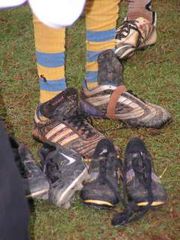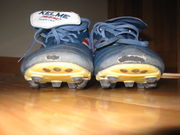Football boot

Football boots, called cleats in North America, are an item of footwear worn when playing association football (soccer). Those designed for grass pitches have studs on the bottom to aid grip. Modern "boots" are not truly boots in that they do not cover the ankle.
Contents |
History

The first record of a pair of football boots occurs when Henry VIII of England ordered a pair from the Great Wardrobe in 1526.[1] The royal shopping list for footwear states: "45 velvet pairs and 1 leather pair for football".[2] Unfortunately these are no longer in existence.
In association football's Laws of the Game, Law 4: Player's equipment deals with football boots. Until 1891, any kind of projection on the soles or heels of football boots was strictly forbidden. The 1891 revision allowed both studs and bars, so long as they were made of leather and did not project more than half an inch, and they had their fastenings driven in flush with the leather. Studs had to be rounded, neither conical nor pointed and not less than half an inch in diameter. The leather studs were originally hammered into the boots on a semi-permanent basis and players would have several pairs of boots with different length studs, but in the mid-1950s Adidas introduced boots with interchangeable screw-in studs made of rubber or plastic for varying weather conditions. Football boots were originally heavy boots with protection for the ankle, and these remained the standard style of boot in northern Europe for many years where the boots needed to stand up to the rigours of use on muddy winter pitches. A lighter boot without ankle protection and resembling a studded shoe became popular in southern Europe and South America where pitches were generally harder and less muddy and this eventually became the standard style.
Timeline:
1800’s: During the 1800’s football became extremely popular in Britain. People who played would wear their heavy and hard work boots to play. These were the first ever boots with the steel toed cap at the front and the long laces and ankle support. These boots also had metal studs or tacks put in them at the bottom so the players would have more stability on the pitch. In the later period of the 1800’s the first ever football boot was designed, made of thick and heavy leather which ran right to your ankle for increased protection, the first boot weighed 500g and would double in weight when it was wet.
1900-1940’s: Between 1900-1940 football boots style stayed very basic because of the second world war. However, in this period of time, many famous football boot producers come about, the likes of Gola, Hummel and Valsport came about and were very popular.
1940-1960’s: After the Second World War, the designs of the football boot changed dramatically and really started to make an impact on the game. The South Americans designed a more light and more flexible boot. This design was focused on increasing good control and better kicking power rather than a more protective boot.
1960’s: In the 1960’s the football boot technology really took a huge step, which saw many football boots designed with a lower cut. These enabled the best players in Europe and South America to move faster and change direction quicker.
1970-1980’s: The 1970’s and the 1980’s saw many great advances and changes the in the football boot design. The 1970’s saw technology produce many more light boots and a variety of colours. In this decade, players started to get paid to wear a certain brand of boots. Finally in the
1980’s, probably the most popular and dominant boot in the world the Adidas Predator was designed.
1990-2000’s: In the 1990’s this saw football boots introduce different types of studs to increase the balance of the player. The Predators once again dominated this era and a more flexible sole was introduced. In the 2000’s laser technology was introduced to produce the first fully customized football boot.
Different styles for different sports

Depending on the type of surface, kind of sport and even the wearer's position or role in the game, different cuts of boot and particularly stud arrangements are available. For hard fields, amateur participants may wear a sneaker shoe or a plastic-stud boot (known as a "moulded sole"); in most sports and positions this is adequate, although on a well-grassed or sodden field, a screw stud is recommended for more grip; these may be metal, rubber or plastic. Presently, boot designs are based on the criteria of speed, power, touch or control with some boots offering a combination of these.
For indoor soccer, indoor cleats are used[3]. These come in many styles, some with studs and some without. They vary greatly from normal soccer cleats.[4]
For rugby union, the screw-in stud (or in some cases a metal-tipped, moulded stud) is preferred, especially in the positions of prop, hooker, and lock, where more grip is required for contested scrums. These screw-in studs have to be completely of metal construction not plastic with metal tips, of a maximum length of 21mm. These boots are often heavier than appropriate for other types of football. One of the more obvious differences between football and rugby boots is the formation of the studs. Also, some rugby boots tend to have a high cut around the ankles. There are several types of rugby boot, meant for players in different positions.
Screw-in studs have been banned in some Australian rules football leagues since the 1990s due to the frequency of severe injuries to players as a result of contact with the metal. In football, referees must now check all boots prior to kick off to check for damage to studs, to prevent injury. Before this time, preference between the screw-in stud was based primarily on weather conditions.
More recently, moulded soles with specially designed boots known as blades have moulded soles facing in multiple directions, theoretically to maximise grip and minimise ankle injury. Recently, however, "bladed" football boots have faced criticism from some UK sporting bodies for causing potentially serious injuries to players. English football club Manchester United have even banned its players from wearing boots with bladed studs after players like Wayne Rooney and David Beckham suffered repeated metatarsal injuries.[5]
Association football markets and brands

Originally, association football boots (soccer shoes, or more commonly soccer cleats, in U.S. English[6]) were available only in black, but in more recent years have become available in various colours such as blue, green, red, white, yellow, silver, gold and even pink. Big name companies such as Nike, Adidas, Umbro and the like have made an impact on the market with record sales. Nike's flagship shoe is the Mercurial Vapors worn by Cristiano Ronaldo, with other versions such as Total 90 football boot worn by Wayne Rooney. German company Adidas are responsible for the Predator range worn by David Beckham, Gary Neville, and Steven Gerrard. The entire German national side wore Adidas boots during the 2006 FIFA World Cup. English firm Umbro produce the Speciali boot endorsed by John Terry and Michael Owen.[7] Manchester United midfielder-cum-defender John O'Shea wears the Concave football boot - it is a Canadian company that claims to manufacture the safest football boot out of the current lot.[8]
In recent times, the most successful of these companies is Nike, and their products enjoy great popularity among professional footballers; among Nike's endorsers are two-time FIFA World Player of the Year Ronaldinho, aforementioned duo Wayne Rooney and Cristiano Ronaldo, striker Ronaldo, and other popular players. Adidas, which has been providing football boots with screw-in studs to the German national side since the 1954 FIFA World Cup, have made their impact on the modern market by signing big name players as endorsers: players such as David Beckham, former France captain Zinedine Zidane, Frank Lampard, Steven Gerrard and other successful players. Adidas sells with an image of technology and class in their boots which is key to their success. Umbro, meanwhile, is the weakest link of the big name companies in terms of footwear sales, but has a strong association with the England team, whom it produces equipment for to add to the endorsement deals with John Terry and Michael Owen, among others. Both Chelsea and Manchester United had enjoyed long kit manufacturing deals with Umbro, but both teams signed recent deals with Adidas and Nike respectively.
References
- ↑ Chaudhary, Vivek (2004-02-18). "Who's the fat bloke in the number eight shirt?". The Guardian (London). http://arts.guardian.co.uk/news/story/0,,1150460,00.html. Retrieved 2010-05-02.
- ↑ History of Football Boots, Soccerlens, 2008-07-18. Retrieved: 2010-07-02.
- ↑ "Indoor Cleats". http://indoorcleats.com. Retrieved 2010-8-18.
- ↑ "How Are Indoor Cleats Different?". http://indoorcleats.com/how-are-indoor-cleats-different. Retrieved 2010-8-16.
- ↑ "Ferguson wants bladed boots ban". BBC News. 2005-09-24. http://news.bbc.co.uk/sport1/hi/football/teams/m/man_utd/4277722.stm. Retrieved 2010-05-02.
- ↑ "soccer player". Visual Dictionary Online. Merriam-Webster. http://visual.merriam-webster.com/sports-games/ball-sports/soccer/soccer-player.php. Retrieved 2009-04-28.
- ↑ Nike vs Adidas - Battle of the Boots, Soccerlens, 2010-05-24. Retrived: 2010-07-02.
- ↑ Concave PT Metatarsal Injuries, Soccerlens 2010-05-29. Retrieved: 2010-07-02.
External links
|
|||||||||||||||||||||||||||||